Parallel Curriculum Units for Science, Grades 6-12
- Jann H. Leppien - University of Great Falls
- Jeanne H. Purcell - Connecticut State Department of Education
"Teachers at various stages of professional development in curriculum design will find these materials powerful examples that will guide their growth and development and sharpen their skills."
—Mary L. Slade, Professor
James Madison University, Harrisonburg, VA
Supercharge your science curriculum to challenge all students
Based on the best-selling book The Parallel Curriculum, this professional development resource gives multifaceted examples of rigorous learning opportunities for science students in Grades 6–12. The four sample units revolve around genetics, the convergence of science and society, the integration of language arts and biology, and the periodic table. The editors and contributors provide user-friendly methods for creating more thoughtful lessons and show how to differentiate them for the benefit of all students. Included are field-tested and standards-based strategies that guide students through:
- Exploring the nature of knowledge
- Discovering connections between science and other subjects
- Deepening science comprehension according to their interests and abilities
- Connecting science to society through the study of genetics, historic events, literature, and chemistry
Each unit includes subject matter background, a content framework, study components, teacher reflections, and sample lessons. Also available are online content tools such as handouts, PowerPoint presentations, and research activities. Breathe new life into science learning with this powerful guidebook written by master educators!
Supplements
“The parallel curriculum model provides a useful framework for creating lessons that are appropriate for all students. Applying it to science, the authors challenge students to think critically in all they do, synthesizing material within the STEM disciplines as well as reaching out to connect to the humanities. The teacher reflections offer relevant tips to maximize the effect of each aspect of the lesson. Most of all, the authors respect their students and their right to interact with challenging curriculum. I highly endorse these units for secondary students and am so excited with the challenge these units provide.”
"Dr. Leppien and her colleagues provide a user-friendly approach to motivating young people through meaningful scientific investigations. I am pleased to incorporate this text into my graduate courses in gifted education."
"Teachers at various stages of professional development in curriculum design will find these materials powerful examples that will guide their growth and development and sharpen their skills."
“President Obama stated that 'Science is more essential for our prosperity, our security, our health, our environment, and our quality of life than it has ever been' (2009). This statement speaks to an urgent call for young people to acquire increased scientific knowledge. This book addresses that need by providing carefully designed, highly engaging, and intellectually stimulating lessons."
Sample Materials & Chapters
Chapter 1: Genetics: Our Past, Present, and Future: A Middle School Unit for Gra
